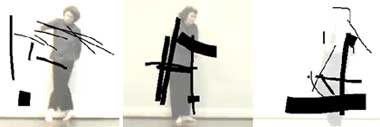Simply recording on video also isn't enough, as it lacks all the advantages of symbolic transcription: yes, you can see what's happening, but how are you to explain it? How are you to know if what you're doing is the same? It all requires quite a lot of imagination, and one usually ends up confused and unable to really "get the real thing".
So how is a choreographer to mark down what he's come up with?
Here is a new, pretty solution:
Rotosketch is an intuitive tool for sketching, doodling and notating on top of video, such that the marks that are made are linked in time with the video. This allows the user to draw strokes along the the axis of time, as well as the normal x and y axes, and for those strokes to augment, analyze, interpret, or even obliterate a video sequence.

ps: Following the comment that "this has been done before. done a lot":Yes, it has. Using software to work with choreography has an entire history, that goes back at least to the great Merce Cunningham's 1989 performance with the program Life Forms. There were - and are - many other choreographers and programmers that followed. I'm not specialist on the matter - read more about it here and here and here. (Some examples of software are Isadora, the Choreograph, the Chaographer and the Interactive Choreographic Sketchbook). However, what seems to me particularly appealing about the Rotosketch is a combination of factors: 1) the possibility of including time as one of the variables in the sketch; 2) the "photoshop" characterisics that make it easy and intuitive (just use the pen and pad...); 3) the availability of the software (free download on the net); 4) the possibility of playing between the level of choreography and drawing. As you can see on the video, the sketch is really an interpretation of the draughtsman/analyst, allowing for a more personal, less software-dependent approach.
(via)
Technorati:

6 comments:
this has been done. done alot.
One of the artist envolved in that project is Zachary Lieberman (media/digital artist). He has done something similar with singers...
Of course this has been done before a lot... But there is still a lot to do. This work is not only about dance, but a research haow to combine things.
Zachary studied painting and he is interesting in moving paintings.
Sorry about the knee jerk reaction, I live a very media saturated life. The post caught me on the same day that I noticed a large sign in front of where I work with J. Holzer style statements running for their ‘irony’ level and was thinking about the fine line between ‘High Art’ and ‘Base commercial’ media projects. Not to say that levels of re-exploration can not result in positive and expressive results, by ‘done’ I meant the technique and basic execution problems have been solved on many levels and conceptually come to fruition. Lozano-Hemmer, is a good example of someone who has taken it a step further. 'Media Art'/'New Art' (or whatever you want to all it) runs the risk of relying to heavy on its ‘g-wiz’ factor and suffers from science-fair-ication.
Dear no-where-man, I'm glad you put that first post, which prompted me to elaborate.
I agree entirely with your mixed feelings towards new/media art. I've written about it several times - see, for example:
http://new-art.blogspot.com/2005/04/problem-with-technology-in-art.html
and
http://new-art.blogspot.com/2005/05/touch-me.html
thanks for your interesting comment!
omg. fun! i know some of those people mentioned, i was an intern at a gallery that they dealt with during the brief "ephemeria" bubble. we are on the same page here it seems ;)
projects like this i wonder if are not more 'art' pop shamanism.
Post a Comment